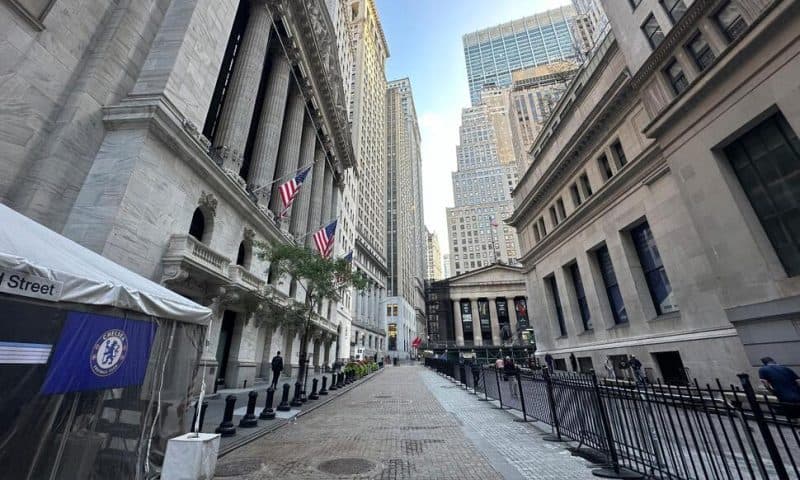U.S. stocks rallied closer to their records after the head of the Federal Reserve finally said out loud what Wall Street has been expecting for a while: Cuts to interest rates are coming soon to help the economy
NEW YORK — U.S. stocks rallied close to their records Friday after the head of the Federal Reserve finally said out loud what Wall Street has been expecting for a while: Cuts to interest rates are coming soon to help the economy.
The S&P 500 rose 1.1% after Fed Chair Jerome Powell said in a highly anticipated speech that the time has come to lower its main interest rate from a two-decade high. The index pulled within 0.6% of its all-time high set last month and has clawed back virtually all of its losses from a brief but scary summertime swoon.
The Dow Jones Industrial Average rose 462 points, or 1.1%, to close above the 41,000 level for the first time since it set its own record in July, while the Nasdaq composite jumped 1.5%.
Powell’s speech marked a sharp turnaround for the Fed after it began hiking rates two years ago as inflation spiraled to its worst levels in generations. The Fed’s goal was to make it so expensive for U.S. households and companies to borrow that it slowed the economy and stifled inflation.
While careful to say the task is not complete, Powell used the past tense to describe many of the conditions that sent inflation soaring after the pandemic, including a job market that “is no longer overheated.” That means the Fed can pay more attention to the other of its twin jobs: to protect an economy that’s slowing but has so far defied many predictions for a recession.
“The time has come for policy to adjust,” Powell said. “The direction of travel is clear, and the timing and pace of rate cuts will depend on incoming data, the evolving outlook, and the balance of risks.”
That second part of his statement held back some of the details that Wall Street wanted so much to hear.
Treasury yields had already pulled back sharply in the bond market since April on expectations the Federal Reserve’s next move would be to lower its main interest rate. The only questions were by how much the Fed would cut and how quickly it would move.
A danger is that traders have built their expectations too high, something they’ve frequently done in the past. Traders see a high likelihood the Fed will cut its main interest rate by at least 1 percentage point by the end of the year, according to data from CME Group. That would require the Fed to go beyond the traditional move of a quarter of a percentage point at least once in its three remaining meetings scheduled for 2024.
If their predictions are wrong, which has also been a regular occurrence, that could mean Treasury yields have already pulled back too much since their decline began in the spring. That in turn could pressure all kinds of investments. On Thursday, for example, the S&P 500 fell to its worst loss in more than two weeks after Treasury yields climbed.
“Like usual, we will be sitting on the edge of our seats not only trying to figure out what the next data point will be, but how the Fed will interpret the data,” said Brian Jacobsen, chief economist at Annex Wealth Management.
For Friday, at least, Powell’s speech heled lead to a widespread rally across Wall Street.
The smaller stocks in the Russell 2000 jumped 3.2% to lead the market. Smaller companies can feel greater benefit from lower interest rates because of their need to borrow to grow.
In the S&P 500 index of big companies, more than 85% of the stocks climbed. The strongest push upward came from Nvidia, which rose 4.5%.
Its stock has been shaky this summer amid worries that investors took it and other highly influential Big Tech stocks too high in their mania around artificial-intelligence technology. But Nvidia has been charging back recently ahead of its highly anticipated profit report scheduled for next week.
Most of the other companies in the S&P 500 have been reporting better-than-expected profit so far this reporting season, as is usually the case.
Ross Stores added 1.8% after topping analysts’ estimates for profit and revenue during the latest quarter. But CEO Barbara Rentler also said the retailer’s low- and moderate-income customers continue to feel the pressure of high prices across the economy, even if inflation has slowed. It’s a concern that many CEOs have been echoing recently.
That helped offset an 8.2% tumble for Red Robin Gourmet Burgers, which reported a worse loss for the latest quarter than expected. It cited a slowdown across the restaurant industry.
All told, the S&P 500 rose 63.97 points to 5,634.61. The Dow jumped 462.30 to 41,175.08, and the Nasdaq composite gained 258.44 to 17,877.79.
In the bond market, the yield on the 10-year Treasury fell to 3.79% from 3.86% late Thursday. The two-year Treasury yield, which moves more closely with expectations for action by the Fed, dropped to 3.91% from 4.01% late Thursday.
In stock markets abroad, indexes rose modestly in Europe after finishing mixed across Asia.
The Nikkei 225 added 0.4% in Tokyo after Bank of Japan Gov. Kazuo Ueda appeared to indicate more increases to interest rates may be coming, but they would be gradual.
The Bank of Japan helped set off a scary summertime swoon in financial markets after a rate hike forced many hedge funds and other investors to abandon a popular trade all at once. An ensuing assurance from a top bank official that it wouldn’t raise rates again as long as markets were unstable helped calm conditions.

